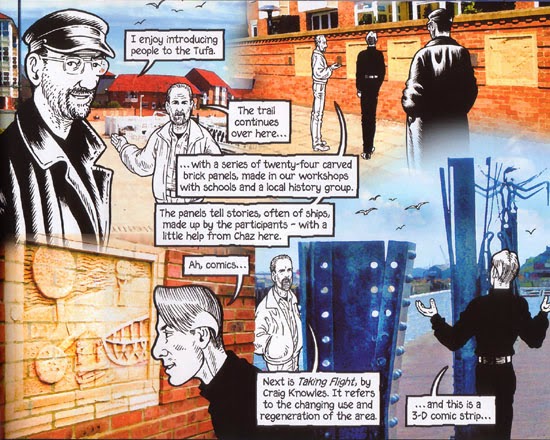More on Bryan Talbot's ALICE IN SUNDERLAND....
It's hard to know where to begin with Bryan Talbot's new book. To get one thing out of the way, it is a comic book. And it is a graphic novel, Percy. And it's brilliant. That part is simple. Those we can agree on. It's also a history of Lewis Carroll's creation of ALICE IN WONDERLAND and THROUGH THE LOOKING GLASS, with particular reference to the influence of the history and geography of Talbot's current stomping grounds in the Sunderland region of the British north-east, in opposition to the established Oxford-based history of Carroll and trying to distinguish fact from legend. Going beyond the initial creation, it's also a history of the enduring legacy of Carroll's work in popular culture. It's also a history of the Sunderland region, with particular references to the role of people connected to Carroll and his family, and the family of Alice Liddell, the partial template for the Alice character. It's also a history of comic books, again with particular reference to connections to the Sunderland region and ALICE. And that just scratches the surface. In the end, the best description is, unsurprisingly, the one that Talbot gives in the subtitle, "An Entertainment". Fact and fiction, art and history, comedy and tragedy, photography and illustration, politics and the personal. Anything is fair game, as long as it's entertaining.
The other title of the book is "A Night at the Empire", which points to the main structure of the book, a stage presentation at the Sunderland Empire theatre of all things interesting to Bryan Talbot, as told to an audience of one, Bryan Talbot (the Plebeian), by Bryan Talbot (the Performer), with asides and journeys through time and space provided by Bryan Talbot (the Pilgrim). There's yet a fourth Bryan Talbot (and possibly a fifth) who figures into the book later. This is all in addition to the real Bryan Talbot (Para 00.72.87) who actually created it all. "I get the feeling I've been here before"
The number of Talbots is appropriate because the key to it all, beyond ALICE, beyond Sunderland, beyond comics, is the "all things interesting to Bryan Talbot", so he throws it all in here if he can find even a tenuous connection to the main topic (and as he mentions, some of these themes have been in his mind and have seeped into his work for 30 years). He's obviously interested in the act of creation in all forms, so he begins with an examination of his creation of comics with the same opening page of the arrival in the theatre, presented as a sketch, a detailed pencil image with construction lines intact and in finished inks. That lets you in on the fact that much of the story will be told backstage. Not only what was created, but how and why it was created, and Talbot extends that backstage look to his own work.
Now, about that act of creation of this book. I've always been critical of the use of photos, computer effects and the like mixed with traditional comics. I admired some of what Jack Kirby tried to do with collage elements back 30-40 years ago, but never thought they worked, whether because of the poor reproduction or jarring contrast, and always end up thinking that Kirby could probably have drawn an image twice as captivating in half the time. I thought Dave McKean did some fascinating mixed-media stuff in CAGES, but in general always prefer his illustration work to his mixed photo-collage stuff (and hence these are my favourite SANDMAN covers. And hey, one of them is drawn by Talbot. So it goes (actually, I asked Talbot about that, since with his recent passing Vonnegut was on my mind as I read SUNDERLAND and the themes and structure of both it and some of Talbot's earlier work seem to echo Vonnegut, and was surprised that he actually hadn't read SLAUGHTERHOUSE FIVE, though he had seen the movie. Hence ruining my intention to title this review/essay "Listen: Bryan Talbot has come unstuck in time". But you see how I snuck that line in anyway?)). Scott McCloud's LINCOLN book still drives me crazy. As I mentioned a few months back, I had a lot of problems with some of experimental photo stuff that Eddie Campbell used in FATE OF THE ARTIST (although I don't question that it's a graphic novel, Percy). I happily admit to old-fogeyism with regards to comics creation.
So I was kind of doubtful about SUNDERLAND when I saw how heavily Talbot was hitting the photo manipulation, and fully expected to be despairing how someone with such a perfect ink line was wrecking his art by sticking in all these photos. This turned out not to be the case at all. Given my inclinations, I'm amazed at how seamless the integration of line-art, original photography and archival photography in this book. Maybe it's because of the on-stage/backstage, fact/fiction structure, and the constant tweaking of styles to emulate other comics, Talbot's fairly remarkable skills with the computer or the completely captivating narrative, but with very few exceptions I didn't see any conflict between the art and photos, where normally I see nothing but conflict. I'm convinced of photos and computers as perfectly acceptable comic book creation tools.
(Not so much that I don't still hope that Talbot's next book is pure brush-on-paper. I'm not that over my fogeyism)
This has gone on longer than I'd planned, so I'll call a halt to it now. Or possibly an intermission. You never know. I might also use SUNDERLAND to launch a few other posts on topics it brings to mind. A reminder, Talbot's site has over two dozen pages from the book, including the brilliant 3-page "Jabberwocky" adaptation. They don't capture the effect of the pages in context in the stunningly well printed book, but they're a taste.


No comments:
Post a Comment